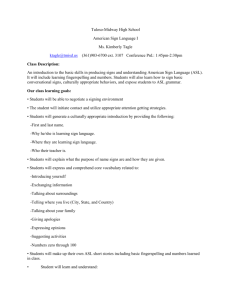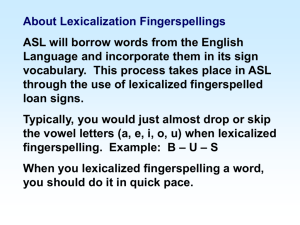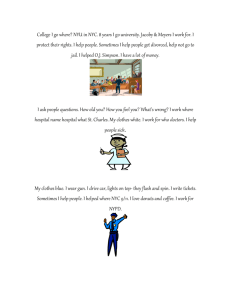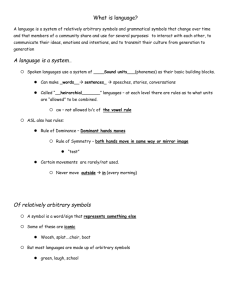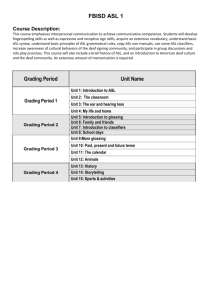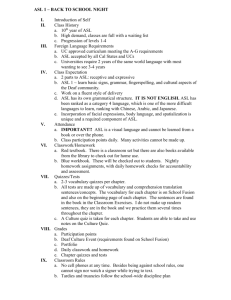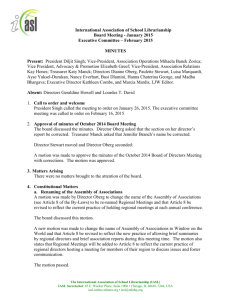AMERICAN SIGN LANGUAGE
advertisement
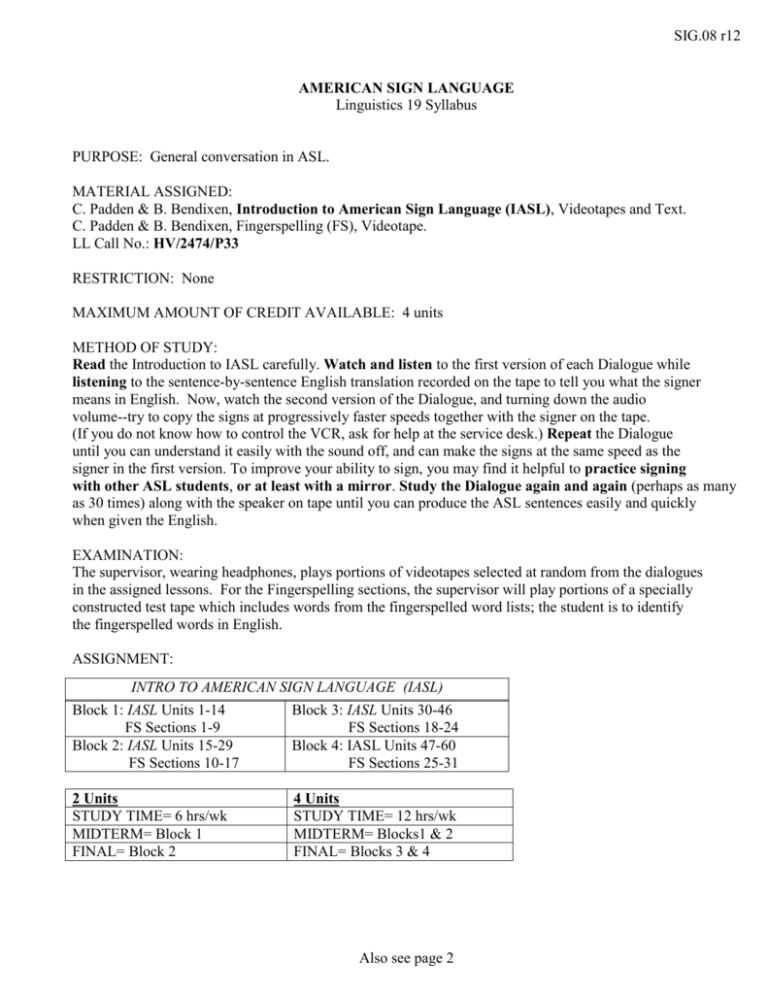
SIG.08 r12 AMERICAN SIGN LANGUAGE Linguistics 19 Syllabus PURPOSE: General conversation in ASL. MATERIAL ASSIGNED: C. Padden & B. Bendixen, Introduction to American Sign Language (IASL), Videotapes and Text. C. Padden & B. Bendixen, Fingerspelling (FS), Videotape. LL Call No.: HV/2474/P33 RESTRICTION: None MAXIMUM AMOUNT OF CREDIT AVAILABLE: 4 units METHOD OF STUDY: Read the Introduction to IASL carefully. Watch and listen to the first version of each Dialogue while listening to the sentence-by-sentence English translation recorded on the tape to tell you what the signer means in English. Now, watch the second version of the Dialogue, and turning down the audio volume--try to copy the signs at progressively faster speeds together with the signer on the tape. (If you do not know how to control the VCR, ask for help at the service desk.) Repeat the Dialogue until you can understand it easily with the sound off, and can make the signs at the same speed as the signer in the first version. To improve your ability to sign, you may find it helpful to practice signing with other ASL students, or at least with a mirror. Study the Dialogue again and again (perhaps as many as 30 times) along with the speaker on tape until you can produce the ASL sentences easily and quickly when given the English. EXAMINATION: The supervisor, wearing headphones, plays portions of videotapes selected at random from the dialogues in the assigned lessons. For the Fingerspelling sections, the supervisor will play portions of a specially constructed test tape which includes words from the fingerspelled word lists; the student is to identify the fingerspelled words in English. ASSIGNMENT: INTRO TO AMERICAN SIGN LANGUAGE (IASL) Block 1: IASL Units 1-14 FS Sections 1-9 Block 2: IASL Units 15-29 FS Sections 10-17 Block 3: IASL Units 30-46 FS Sections 18-24 Block 4: IASL Units 47-60 FS Sections 25-31 2 Units STUDY TIME= 6 hrs/wk MIDTERM= Block 1 FINAL= Block 2 4 Units STUDY TIME= 12 hrs/wk MIDTERM= Blocks1 & 2 FINAL= Blocks 3 & 4 Also see page 2 SIG.08r12 Special Information for AMERICAN SIGN LANGUAGE ASL is the manual language used by Deaf people in America. There are many dialects of sign language. Deaf people mainly use “Signed English” when speaking to “hearing” people; among themselves they use “ASL”, formerly called Ameslan. ASL and Signed English share the same set of signs (manual gestures). Users of Signed English essentially translate English sentences into manual gestures: making one sign for each word, using English word order, and preserving all the grammatical endings in English (-s, -ing, etc.). ASL has its own grammar: e.g., the word order is quite different from that in English. Signed English uses much more fingerspelling (i.e., the manual alphabet) than Ameslan, while Ameslan uses much more pantomime. The self-instructional ASL course in the UCSD Language Laboratory (P&L 2126) has two parts: dialogues and fingerspelling, with emphasis on fluent conversation. There is a fast and a slow version of each ASL dialogue on the videotape; for examinations you will be expected to say what the fast version of each dialogue means in English. The separate vocabulary lists at the end of the book (and separate videotape) are designed to get you reading fast fingerspelling. After learning the manual alphabet, you will be presented with tests of fingerspelled words, beginning with three- and four-letter words spelled at a moderate rate. The fingerspelling test will use a special test tape of a different signer fingerspelling words that you know in random order. You will be expected to read the words quickly: be sure to practice the fingerspelling with the sound turned off! Silent study with a partner is encouraged. Put on a fingerspelling tape and see who can guess the words first. Practice signing to each other. After all, Sign Language can be used between cars, and in lecture halls or libraries, etc., without breaking the silence. At the Language Lab service counter there is a videotape called “Burning Rubber” which features a group of Deaf performers signing the lyrics to 1950’s rock music, a la Sha Na Na. It’s fun, and after four weeks of this course you’ll be able to understand the signs. Last revised 8/01

